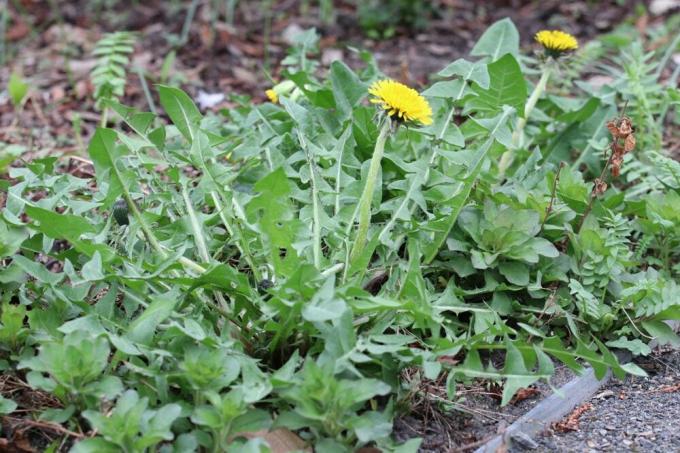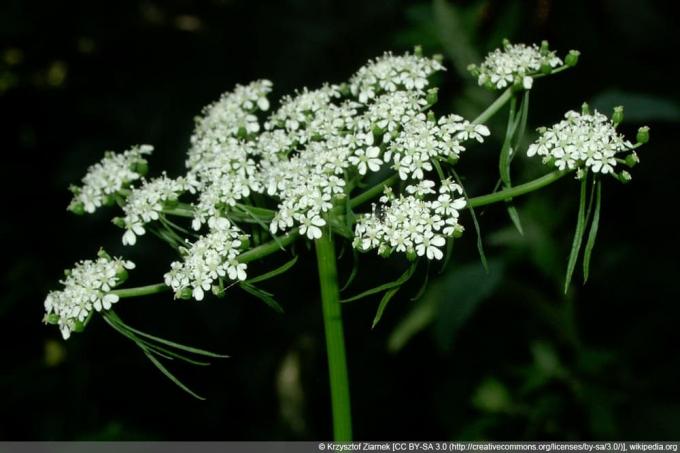
Table of contents
- Fight Giant Bear Claw
- Health Risks and Precautions
- How to take effective action against Bärenklau
- Final Tips
- Characteristics
- particularities
- species
Unfortunately, it can become very uncomfortable for humans at the slightest contact. Therefore, the giant Bärenklau should be fought, which is not easy and can take time. There are some important tips to keep in mind when fighting:
Fight Giant Bear Claw
- The Giant Bear Claw (Heracleum mantegazzianum) originally only grew in the Caucasus, but was already used in the 19th century. Introduced to the European part of Eurasia in the 19th century. The imposing perennial is not welcomed here, it not only threatens people, but also the native flora and fauna by displacing native plants and causing considerable erosion damage on the banks of water bodies caused.
- People should beware of any contact with the huge umbel, the sap of all parts of the plant contains furanocoumarins. These are photosensitizing substances that sometimes cause severe, burn-like damage to the skin that heals poorly Skin cause when skin is exposed to normal UV radiation from sunlight after contact with the plant becomes. For sensitive people and children, even a longer stay next to the plant can be sufficient, UV light can trigger the harmful effects even days later. The phototoxic substances develop their greatest effectiveness when the UV radiation occurs 30 minutes to 2 hours after contact with the plant, the symptoms appear after about 24 hours.
Health Risks and Precautions
- Therefore applies to all people who actively participate in the fight against the giant Bärenklau: A complete protective outfit is mandatory, full clothing made of thick and strong fabric, gloves and goggles that also cover the eye area laterally protects. The work should be carried out when the sky is overcast or in the evening, as the UV radiation is lower at these times. They should not be electrically powered brush cutter (brush cutters, lawn trimmers) because with these devices there is a very high risk that plant sap will be sprayed.
- If sap gets on skin, it should be washed off immediately with soap and water. Depending on the size of the affected skin area, you should consult a doctor as a precaution. In any case, the affected areas must not be exposed to sunlight for at least 72 hours. You must continuously protect these areas with sunscreen for the next few months.
- The Hercules perennial is therefore spreading more and more because it is capable of growing an incredible number form floating seeds, up to 50,000 pieces, which then last up to ten years remain viable.
- The Fighting the Hercules shrub should therefore be planned well: In order to get the unpleasant growth under control, it usually has to be fought consistently for several years in a row. Because if a few seeds are forgotten in an area that has already been assumed to be liberated, the giant perennial soon celebrates its resurrection happily. It is recommended to fight even smaller stocks immediately. They usually spread the fastest, but can be pushed back from the outside inwards if you react quickly. Consistent use can even clear heavily infested areas, you just have to keep at it for several years. The annual follow-up checks in spring are particularly important, which is why you should note the individual plants on a card. Also, the affected soil should be densely planted with vigorous, assertive plants so that the seeds waiting in the soil never get enough light to germinate.
How to take effective action against Bärenklau
The most important and most promising way of combating it is to cut off the vegetation cone. This is best done in the spring up to around mid-May, when the plants are still low and fighting without skin contact is easier. The giant hogweed has a root in the classic turnip shape, from which you have to cut the top 15 to 20 cm underground to kill the plant. This upper vegetation cone is then discarded in the garbage, the root base rots in the ground. Detaching works well with a sharp, narrow spade, maybe with a pickaxe, but here the sap can quickly splatter all over the place! If offspring appear, this strategy can be repeated until October, which also makes work easier next spring.
With large plants that are overlooked in spring, it becomes difficult to root out. It is worthwhile, especially when the inflorescences are so far developed that cutting off the upper leaf mass would inevitably disperse the seeds It is worth considering whether the upper part of the perennial should be "dropped" onto an old tarpaulin, which is then packed up from the sides to form a package and disposed of becomes.
Against the Hercules tree can Herbicides (weed killers) used with a systemic effect. With these remedies, the active ingredient is absorbed through the leaves and then carried to the root. The giant hogweed is best chemically treated when it is between half a meter and a meter tall, from the beginning of June it is usually too tall (this Leaf masses could no longer be killed by the weed killer), it would then first have to be cut off (taking all the precautions mentioned above into account). become.
Final Tips
But just cutting off is never enough to fight the giant Bärenklau. Because the roots remain in the ground, the assertive perennial is even capable of forming mostly unnoticed emergency flowers, which then also ensure propagation.
A campaign against the Hercules shrub should not be carried out alone if possible. Contact your local plant protection office: in many communities the state road construction offices are already in place fighting hogweed, these organizations also have other pesticides at their disposal Disposal. You may agree on a combined approach with the contractors in the municipality.
Characteristics
Type/Family: wild perennial. Belongs to the acanthus or bear claw family (Acanthacea)
Maintenance effort: Small amount
heyday: July to September with 60-70 long, upright racemes of white, violet or pink flowers with pink caps. Buds are also pink. Flowers are reminiscent of lupins
foliage: Large, up to 35 cm long, deeply cut, spiky, dark green, partly white-edged leaves with high ornamental value. Reminds me a little of thistle leaves
Growth: Bushy, upright strong growth with runners
Height/Width: 90 to 100 cm high, 60 to 75 cm wide
Location: Sunny to semi-shady warm. Light and well-drained, but moist normal garden soil that should not be too nutritious
planting time: Anytime as long as the ground isn't frozen. Can be sown directly outdoors in spring
Cut: Cut back to the ground in spring
Partner: wild perennials
propagation: Divide in the spring or propagate with root cuttings, they will not flower until the following year
Care: Water if dry. Fertilizer not necessary
Wintering: Grateful for winter protection of the rootstock in harsh areas. Container plants are more sensitive to cold than planted specimens
particularities
- Comes from the Balkan Peninsula, but is now native to us and can often be found wild on the edges of forests
- Is also suitable for the bucket
- Leaves were immortalized on stone pillars by the ancient Greeks
- Very poisonus
- Good bee pasture
- Inflorescences can be cut well for the vase; stable and long lasting. Also beautiful as dried flowers
species
- Thorny Acanthus (Acanthus spinosissimus)
- Conspicuous prickly green foliage edged with white
- Spiny Acanthus (Acanthus spinosus)
- Height 90-100cn, width 60-75cm. Blooms in white or purple from mid to late summer
 garden editorial
garden editorial I write about everything that interests me in my garden.
Learn more about weed control - weed control in the garden

Japanese knotweed: 11 remedies to combat it
Japanese knotweed allows areas to be greened quickly. However, the rapid growth makes the creeper a problem in nature. We've rounded up 11 ways to combat the invasive species.

remove dandelions | 7 Tips to Destroy, Get Rid of & Eliminate
The dandelion is a feast for the eyes only in fairy tales. In the garden, on the other hand, it turns out to be an annoying weed. You want one thing above all: get rid of him quickly. However, it is not that easy. How to fight him is here.

Recognizing dog parsley & avoiding confusion | Is she poisonous?
Parsley is one of the most important herbs in the kitchen and is often grown in the garden. In addition to the edible parsley, there is also a wild relative, the dog parsley. It looks confusingly similar to the edible version, but it is poisonous and can even be fatal in large quantities.

Hydrochloric acid against weeds, bamboo and ivy | Are acids allowed?
Weeds are annoying. Removing it is one of the most tedious and unpleasant jobs in the garden. Of course, one thinks about a radical solution to the problem. However, using hydrochloric acid against weeds is not a good idea and is not permitted.

Where are weed killers banned? That's what the law says...
Weed killers are practical - but not allowed everywhere. Where are they banned and what does the law say about them? We inform hobby gardeners about the most important rules for plant protection and legal, natural alternatives for weed killing in their own garden.

Removing Weeds: 9 Effective Sidewalk Remedies - Salt/Vinegar Info
Moss and weeds like to sprout in the joints of the paved garden paths. So the sidewalk, the driveway and also the terrace become an unkempt eye-catcher. But there are many effective ways to clean the paths and this does not necessarily require the chemical mace.
